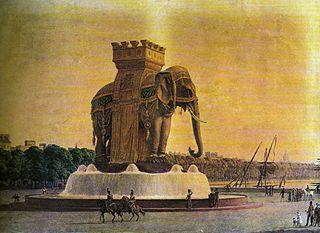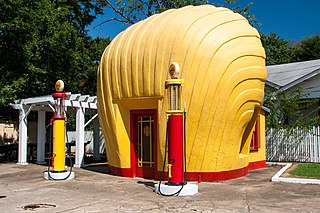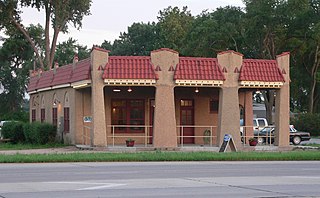
Zillah is a city in Yakima County, Washington, United States, with a population of 3,179 as of the 2020 census.

A roadside attraction is a feature along the side of a road meant to attract tourists. In general, these are places one might stop on the way to somewhere, rather than being a destination. They are frequently advertised with billboards. The modern tourist-oriented highway attraction originated as a U.S. and Canadian phenomenon in the 1940s to 1960s, and subsequently caught on in Australia.

The Chester teapot is billed as the "World's Largest Teapot", which measures 14 feet (4.3 m) in height by 14 feet (4.3 m) in diameter. Its current location is on the former site of a popular amusement park, Rock Springs Park (1897–1970), off an onramp along U.S. Highway 30 in the City of Chester in Hancock County, West Virginia.

Novelty architecture, also called programmatic architecture or mimetic architecture, is a type of architecture in which buildings and other structures are given unusual shapes for purposes such as advertising or to copy other famous buildings without any intention of being authentic. Their size and novelty means that they often serve as landmarks. They are distinct from architectural follies, in that novelty architecture is essentially usable buildings in eccentric form whereas follies are non-usable, purely ornamental buildings also often in eccentric form.

Fanwood is a New Jersey Transit railroad station on the Raritan Valley Line, in Fanwood, Union County, New Jersey, United States. The building on the north side of the tracks is a Victorian building and, like the north building at Westfield, is used by a non-profit organization. The address is Fanwood Station, 238 North Avenue, Fanwood, Union County, New Jersey. The ticket office is in the station building on the south side of the tracks. The station was added to the National Register of Historic Places on July 17, 1980.

U.S. Route 66, the historic east–west US highway between Chicago, Illinois and Santa Monica, California, passed through one brief segment in the southeastern corner of Kansas. It entered the state south of Baxter Springs and continued north until it crossed Brush Creek, from where it turned east and left the state in Galena. After the decertification of the highway in 1985, this road segment was numbered as US-69 (alternate) from Quapaw, Oklahoma north to Riverton, Kansas and as K-66 from Riverton east to Route 66 in Missouri.

U.S. Route 66 was a United States Numbered Highway in Illinois that connected St. Louis, Missouri, and Chicago, Illinois. The historic Route 66, the Mother Road or Main Street of America, took long distance automobile travelers from Chicago to Southern California. The highway had previously been Illinois Route 4 and the road has now been largely replaced with Interstate 55 (I-55). Parts of the road still carry traffic and six separate portions of the roadbed have been listed on the National Register of Historic Places.

The Shell Service Station in Winston-Salem, North Carolina, is a former filling station constructed in 1930 following a decision in the 1920s by the new local Shell distributor, Quality Oil Company, to bring brand awareness to the market in Winston-Salem. The building is an example of representational or novelty architecture and was listed on the National Register of Historic Places on May 13, 1976. It is located in the Waughtown-Belview Historic District at the corner of Sprague and Peachtree Streets.

Paul Bunyan and Babe the Blue Ox are the names of a pair of large statues of the American folk hero Paul Bunyan and his ox, located in Bemidji, Minnesota. This roadside attraction has been listed on the National Register of Historic Places since 1988.

The Airplane Service Station, also known as the Powell Airplane, is a service station built in 1930 in the shape of an airplane. Located at 6829 Clinton Highway in Powell, an unincorporated community in Knox County, Tennessee, it is on the National Register of Historic Places.

The Fossil Cabin near Medicine Bow, Wyoming, United States, was built in 1932 as a roadside attraction. The cabin is built of dinosaur bones excavated at nearby Como Bluff, using a total of 5,796 bones. The cabin was built as part of a gasoline filling station along US 30 by Thomas Boylan. Boylan had come from California to homestead in Wyoming and had been collecting bones for seventeen years, intending to create sculptures of dinosaurs in front of his house and gas station along the Lincoln Highway.

Teapot Rock, also Teapot Dome, is a distinctive sedimentary rock formation and nearby oil field in Natrona County, Wyoming that became the focus of the Teapot Dome bribery scandal during the administration of President Warren G. Harding. The site was listed on the National Register of Historic Places in 1974.

The White River Entrance to Mount Rainier National Park is a complex of buildings built between 1929 and 1931 to accommodate visitors arriving on the Yakima Park Highway, in the northeastern portion of the park. Like most of the structures in Mount Rainier, the buildings are designed in the National Park Service Rustic style, using natural stone and log materials. The historic district includes the 1933 Men's Mess Hall and Dormitory, believed to be the only surviving camp structure built by the Civilian Conservation Corps in the park.
The Teapot Dome scandal was a bribery incident in the United States that took place during the administration of President Warren G. Harding. Teapot Dome may also refer to:

The Gas Station at Bridge and Island Streets is a historic automotive service station in Bellows Falls, Vermont. Built about 1935, it is a modest yet well-preserved example of period roadside commercial architecture of the period. The Colonial Revival building continues to be used as a service facility; it was listed on the National Register of Historic Places in 1990.
Richardson's Overland Trail Ranch is a complex of seven ranch buildings at the crossing of the Big Laramie River by the Overland Trail. The ranch's main residence was built as a stage station for the trail in 1862. A corduroy road was built at the same time. By 1864 ranching became established around the stage station, primarily by Tom Alsop, Edward Creighton and Charlie Hutton. With Creighton's death in 1874 the land was divided between Alsop on the west side of the river and Hutton on the east side. The ranch on the west side became known as the Heart or Hart Ranch. The ranches at the river crossing became part of the larger Riverside Livestock Company.
John Samuel Margolies was an architectural critic, photographer, and author who was noted for celebrating vernacular and novelty architecture in the United States, particularly those designed as roadside attractions. Starting from the mid-1970s, he began to photograph sites during long road trips, since he was concerned these sites would be displaced by the growing modernist trend. He was credited with shaping postmodern architecture and recognizing buildings that would be added to the National Register of Historic Places through his documentary work. Starting in 2007, the Library of Congress began to acquire his photographs, and created the public domain John Margolies Roadside America Photograph Archive in 2016, consisting of 11,710 scans of color slides taken by Margolies.

The Shady Bend Gas Station, Grocery, and Diner, at 3609 E. Hwy 30 in Grand Island, Nebraska, was built in 1931. It was listed on the National Register of Historic Places in 2008.

















